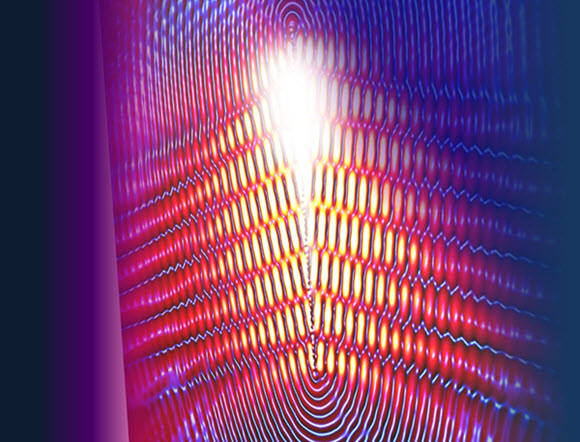Surfing the light fantastic
July 6, 2015

Artistic rendition of the superluminal running wave of charge that excites rface plasmon wakes (credit: Daniel Wintz, Patrice Genevet, and Antonio Ambrosio)
Harvard researchers have created surface plasmons (wakes of light-like waves moving on a metallic surface) and demonstrated that they can be controlled and steered. Their demonstration was based on the Cherenkov effect, in which a charged particle moving with a velocity faster than the phase velocity of light in the medium radiates light that forms a cone with a half angle determined by the ratio of the two speeds.
Wakes occur whenever something is traveling through a medium
faster than the waves it creates — in this case, a boat on Lake Geneva
The discovery, published today (July 6) in the journal Nature Nanotechnology, used rotated nano-apertures etched in a metallic film. It was made in the lab of Federico Capasso, the Robert L. Wallace Professor of Applied Physics and Vinton Hayes Senior Research Fellow in Electrical Engineering at the Harvard John A. Paulson School of Engineering and Applied Science (SEAS).
The creation and control of surface plasmon wakes could lead to new types of plasmonic couplers and lenses that could create two-dimensional holograms or focus light at the nanoscale, according to the researchers.
Surface plasmons are confined to the surface of a metal. To create wakes through them, Capasso’s team designed a running wave of charge along a one-dimensional metamaterial — like a powerboat speeding across a lake.
The metamaterial, a nanostructure of rotated slits etched into a gold film, changes the phase of the surface plasmons generated at each slit relative to each other, increasing the group velocity of the running wave. The nanostructure also acts like the boat’s rudder, allowing the wakes to be steered by controlling the speed of the running wave.
The team discovered that the angle of incidence of the light shining onto the metamaterial provides an additional measure of control and that using polarized light can even reverse the direction of the wake relative to the running wave — like a wake traveling in the opposite direction of a boat.
The observation itself was challenging, as “surface plasmons are not visible to the eye or cameras,” said co-lead author Antonio Ambrosio of SEAS and the Italian Research Council (CNR). “To view the wakes, we used an experimental technique that forces plasmons from the surface, collects them via fiber optics and records the image.”
This research was supported by the National Science Foundation and the Air Force Office of Scientific Research.
Abstract of Controlled steering of Cherenkov surface plasmon wakes with a one-dimensional metamaterial
In the Cherenkov effect a charged particle moving with a velocity faster than the phase velocity of light in the medium radiates light that forms a cone with a half angle determined by the ratio of the two speeds. Here, we show that by creating a running wave of polarization along a one-dimensional metallic nanostructure consisting of subwavelength-spaced rotated apertures that propagates faster than the surface plasmon polariton phase velocity, we can generate surface plasmon wakes, a two-dimensional analogue of Cherenkov radiation. The running wave of polarization travels with a speed determined by the angle of incidence and the photon spin angular momentum of the incident radiation. By changing either one of these properties we demonstrate controlled steering of the Cherenkov surface plasmon wakes.